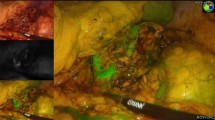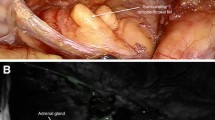Abstract
Background
Indocyanine green (ICG) fluorescence imaging represents an emerging technology that facilitates the assessment of tissue vascularity, tissue distinction, and tumor localization during surgery. The aim of this study was to investigate the potential role of ICG imaging during laparoscopic partial adrenalectomy.
Methods
Indocyanine fluorescence imaging was carried out during laparoscopic partial adrenalectomy for bilateral pheochromocytoma and bilateral Cushing’s syndrome. A first bolus of 5 mg ICG was applied intravenously upon exposure of the retroperitoneal plane to identify the adrenal borders. The fluorescence was visualized using a Storz® NIR/ICG endoscopic system. As the camera of this system detects NIR light as a blue signal, the well-vascularized adrenal tissue was expected to show a strong fluorescence in the blue color channel in contrast to the surrounding adipose tissue. Following partial adrenalectomy, a second bolus of 5 mg ICG was applied intravenously to evaluate the vascularity of the remaining adrenal tissue.
Results
We investigated six adrenal glands from three patients undergoing bilateral partial adrenalectomy. The indication for surgery was pheochromocytoma in two patients and Cushing’s syndrome with bilateral adenomas in one patient. Regarding left adrenalectomies, ICG imaging was helpful in visualizing the adrenal borders and the adrenal vein. Further, it facilitated the identification of the hypofluorescent pheochromocytoma and to resect the entire tumor. On the right side, due to the more apparent anatomy, ICG imaging did not contribute to the conduct of the operation. Four adrenal remnants showed a strong vascularization and two remnants were only reasonably vascularized.
Conclusion
ICG fluorescence may be helpful in guiding partial adrenalectomy and assessing the vascularity of remaining adrenal tissue.


Similar content being viewed by others
References
Fox IJ, Wood EH (1960) Indocyanine green: physical and physiologic properties. Proc Staff Meet Mayo Clin 35:732–744
Alander JT, Kaartinen I, Laakso A, Pätilä T, Spillmann T, Tuchin V, Venermo M, Välisuo P (2012) A review of indocyanine green fluorescent imaging in surgery. Int J Biomed Imaging. https://doi.org/10.1155/2012/940585
Boni L, David G, Mangano A et al (2015) Clinical applications of indocyanine green (ICG) enhanced fluorescence in laparoscopic surgery. Surg Endosc 29:2046–2055
Namikawa T, Sato T, Hanazaki K (2015) Recent advances in near-infrared fluorescence-guided imaging surgery using indocyanine green. Surg Today 45:1467–1474
Aoki T, Murakami M, Yasuda D et al (2010) Intraoperative fluorescent imaging using indocyanine green for liver mapping and cholangiography. J Hepatobiliary Pancreat Sci 17:590–594
Zaidi N, Bucak E, Yazici P, Soundararajan S, Okoh A, Yigitbas H, Dural C, Berber E (2016) The feasibility of indocyanine green fluorescence imaging for identifying and assessing the perfusion of parathyroid glands during total thyroidectomy. J Surg Oncol 113(7):775–778
Zaidi N, Bucak E, Okoh A, Yazici P, Yigitbas H, Berber E (2016) The utility of indocyanine green near infrared fluorescent imaging in the identification of parathyroid glands during surgery for primary hyperparathyroidism. J Surg Oncol 113(7):771–774
Vidal Fortuny J, Belfontali V, Sadowski SM, Karenovics W, Guigard S, Triponez F (2016) Parathyroid gland angiography with indocyanine green fluorescence to predict parathyroid function after thyroid surgery. Br J Surg 103(5):537–543
Lavazza M, Liu X, Wu C, Anuwong A, Kim HY, Liu R, Randolph GW, Inversini D, Boni L, Rausei S, Frattini F, Dionigi G (2016) Indocyanine green-enhanced fluorescence for assessing parathyroid perfusion during thyroidectomy. Gland Surg 5(5):512–521
Jitpratoom P, Anuwong A (2017) The use of ICG enhanced fluorescence for the evaluation of parathyroid gland preservation. Gland Surg 6(5):579–586
Vidal Fortuny J, Sadowski SM, Belfontali V, Guigard S, Poncet A, Ris F, Karenovics W, Triponez F (2018) Randomized clinical trial of intraoperative parathyroid gland angiography with indocyanine green fluorescence predicting parathyroid function after thyroid surgery. Br J Surg 105(4):350–357
Kahramangil B, Berber E (2017) Comparison of indocyanine green fluorescence and parathyroid autofluorescence imaging in the identification of parathyroid glands during thyroidectomy. Gland Surg 6(6):644–648
Dip FD, Roy M, Perrins S et al (2015) Technical description and feasibility of laparoscopic adrenal contouring using fluorescence imaging. Surg Endosc 29:569–574
Kahramangil B, Kose E, Berber E (2018) Characterization of fluorescence patterns exhibited by different adrenal tumors: determining the indications for indocyanine green use in adrenalectomy. Surgery 164(5):972–977
Arora E, Bhandarwar A, Wagh A, Gandhi S, Patel C, Gupta S, Talwar G, Agarwal J, Rathore J, Chatnalkar S (2018) Role of indo-cyanine green (ICG) fluorescence in laparoscopic adrenalectomy: a retrospective review of 55 cases. Surg Endosc 32(11):4649–4657
Manny TB, Pompeo AS, Hemal AK (2013) Robotic partial adrenalectomy using indocyanine green dye with near-infrared imaging: the initial clinical experience. Urology 3:738–742
Benhammou JN, Boris RS, Pacak K et al (2010) Functional and oncologic outcomes of partial adrenalectomy for pheochromocytoma in patients with von Hippel-Lindau syndrome after at least 5 years of followup. J Urol 184:1855–1859
Alesina PF, Hinrichs J, Meier B et al (2012) Minimally invasive cortical sparing surgery for bilateral pheochromocytomas. Langenbecks Arch Surg 397:233–238
Yip L, Lee JE, Shapiro SE, Waguespack SG, Sherman SI, Hoff AO, Gagel RF, Arens JF, Evans DB (2004) Surgical management of hereditary pheochromocytoma. J Am Coll Surg 198(4):525–534
Walz MK, Alesina PF, Wenger FA, Koch JA, Neumann HP, Petersenn S, Schmid KW, Mann K (2006) Laparoscopic and retroperitoneoscopic treatment of pheochromocytomas and retroperitoneal paragangliomas: results of 161 tumors in 126 patients. World J Surg 30(5):899–908
Kaye DR, Storey BB, Pacak K, Pinto PA, Linehan W, Bratslavsky G (2010) Partial adrenalectomy: underused first line therapy for small adrenal tumors. J Urol 184(1):18–25
Sanford TH, Storey BB, Linehan WM, Rogers CA, Pinto PA, Bratslavsky G (2011) Outcomes and timing for intervention of partial adrenalectomy in patients with a solitary adrenal remnant and history of bilateral phaeochromocytomas. BJU Int 107(4):571–575
DeLong JC, Chakedis JM, Hosseini A, Kelly KJ, Horgan S, Bouvet M (2015) Indocyanine green (ICG) fluorescence-guided laparoscopic adrenalectomy. J Surg Oncol 112(6):650–653
Sound S, Okoh AK, Bucak E, Yigitbas H, Dural C, Berber E (2016) Intraoperative tumor localization and tissue distinction during robotic adrenalectomy using indocyanine green fluorescence imaging: a feasibility study. Surg Endosc 30(2):657–662
Colvin J, Zaidi N, Berber E (2016) The utility of indocyanine green fluorescence imaging during robotic adrenalectomy. J Surg Oncol 114(2):153–156
Author information
Authors and Affiliations
Corresponding author
Ethics declarations
Disclosures
Karl Storz GmbH provided a laparoscopic system with a special light source and camera free of charge to Roland Ladurner and Klaus K. J. Hallfeldt. Norah Al Arabi, Maximilian Lerchenberger, Ufuk Guendogar, Julia K. S. Gallwas, and Herbert Stepp have no conflicts of interest or financial ties to disclose.
Additional information
Publisher's Note
Springer Nature remains neutral with regard to jurisdictional claims in published maps and institutional affiliations.
Rights and permissions
About this article
Cite this article
Lerchenberger, M., Gündogar, U., Al Arabi, N. et al. Indocyanine green fluorescence imaging during partial adrenalectomy. Surg Endosc 34, 2050–2055 (2020). https://doi.org/10.1007/s00464-019-06985-7
Received:
Accepted:
Published:
Issue Date:
DOI: https://doi.org/10.1007/s00464-019-06985-7




